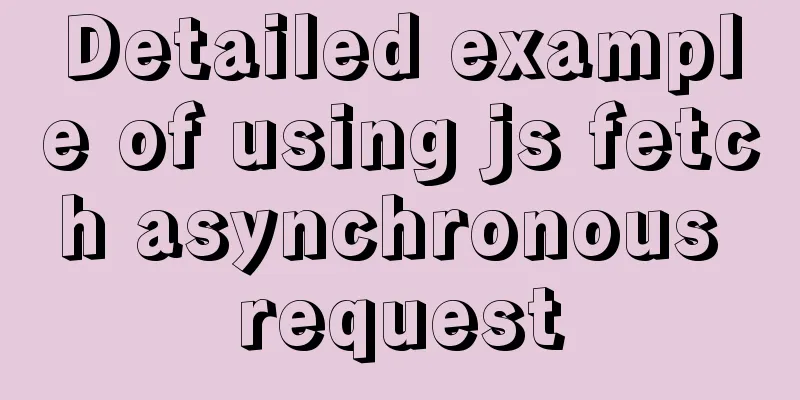Front-end development must learn to understand HTML tags every day (1)

|
2.1 Semanticization makes your web pages better understood by search engines In this chapter, we will begin to introduce the tags commonly used in web pages one by one. When studying this chapter, you must remember that in the process of learning html tags, you should pay attention to two aspects: the purpose of the tag and the default style of the tag in the browser. What is semantics? To put it simply, it means understanding the purpose of each tag (under what circumstances it is reasonable to use this tag). For example, the title of an article on a web page can be written with a title tag, and the names of various columns on a web page can also be written with a title tag. The paragraphs of content in the article must be placed in paragraph tags. If there is text in the article that you want to emphasize, you can use the em tag to indicate emphasis, etc. 2.2 Body tag, the web page display content is placed here The page content to be displayed on the web page must be placed in the body tag. The following figure is a web page of a news article.
2.3 p tag, add paragraph If you want to display an article on a web page, you need the Syntax:
The default style of the <p> tag can be seen in the figure above. There will be blank spaces before and after the paragraph. If you don’t like this blank space, you can use CSS style to delete or change it. Paragraph validation code:
2.4 hx tag, add title There are 6 title tags in total, h1, h2, h3, h4, h5, and h6 are the first-level title, second-level title, third-level title, fourth-level title, fifth-level title, and sixth-level title respectively. And in decreasing order of importance. Syntax:
Note: Because the h1 tag is more important in a web page, it is usually used for the website name. This is what Tencent website does. For example: XML/HTML CodeCopy content to clipboard
Display styles in browser:
From the picture above, we can see that the styles of title tags are all bold, the h1 tag has the largest font size, the h2 tag has a smaller font size than h1, and so on, the h6 tag has the smallest font size. 2.5 strong/em adds emphasis Now that we have paragraphs and titles, if we want to emphasize certain words in a paragraph, we can use There is a difference between the two in the tone of emphasis: grammar: XML/HTML CodeCopy content to clipboard
Examples of em and strong tags:
The content of 2.6 style/span tag, set a separate style for text Let's summarize the three tags The If we now want to set the three words "American Dream" in the first paragraph of the previous section to blue, but please note that this is not to emphasize "American Dream", but just to set a different style for it from other text (and we do not want the screen reader to emphasize the three words "American Dream"), so in this case we can use the grammar: Example: XML/HTML CodeCopy content to clipboard
Displayed in the browser as:
2.7 q tag, short text citation Want to add a quote to your HTML? For example, if you want to quote a poem from a certain writer in an article on your webpage, which will make your article more outstanding, then Note that you do not need to put double quotes around the quoted text; the browser will automatically add double quotes around the q tag. Note XML/HTML CodeCopy content to clipboard
There are no quotation marks in the code, but because it is a 2.8 blockquote tag, long text quotation The function of The Syntax:
XML/HTML CodeCopy content to clipboard
The display effect in the browser is as follows, you can see that the part surrounded by the
2.9 br tag displays text in separate lines How can I add a line break after each line of poetry? Then you can use the grammar:
Summary: Entering carriage returns and spaces in HTML code has no effect. If you want to enter a carriage return and line feed in HTML text, you must enter
Browser effect: 2.10 Add some spaces to the web page It has been explained that entering spaces and entering returns in HTML code will have no effect. To enter a space, you must write Syntax:
XML/HTML CodeCopy content to clipboard
2.11 hr label, add horizontal line When displaying information, sometimes you need to add some horizontal lines for separation, which will make the article look neater. For example, the following web page grammar: html4.01 version The The default style of the XML/HTML CodeCopy content to clipboard
Effect in browser:
2.12 address tag, add address information to the web page Generally, there will be some website contact address information on the web page that needs to be displayed on the web page. This contact address information, such as the company address, can be labeled. It is also possible to define an address (such as an e-mail address), a signature, or the authorship of a document. grammar: The style displayed on the browser is italic. If you don't like italics, of course you can use CSS style to modify the default style of the <address> tag in the following courses.XML/HTML CodeCopy content to clipboard
2.13 code tag, add a line of code In websites that introduce language technology, it is inevitable to display some computer professional programming codes on the web page. When the code is one line, you can use the Note: If it is multiple lines of code, you can use the <pre> tag. XML/HTML CodeCopy content to clipboard
Browser effect:
2.14 pre tag, add large code In the previous section, we introduced that the tag for adding a line of code is
The main function of the
Browser effect:
In the above example, you can see that spaces and line breaks in the code are preserved. If you use the previous method, you need to enter |
<<: js native carousel plug-in production
>>: Detailed explanation of how to manually deploy a remote MySQL database in Linux
Recommend
Alignment issue between input text box and img verification code (img is always one head higher than input)
In web page production, input and img are often pl...
Example analysis of the search function of MySQL regular expressions (regexp and rlike)
This article uses examples to illustrate the sear...
Mybatis statistics of the execution time of each SQL statement
background I am often asked about database transa...
A brief discussion on several specifications of JS front-end modularization
Table of contents Preface The value of front-end ...
How to match the size of text in web design: small text, big experience
With the rise of mobile terminals such as iPad, p...
Common methods and problems of Docker cleaning
If you use docker for large-scale development but...
Solution to the problem that order by is not effective in MySQL subquery
By chance, I discovered that a SQL statement prod...
Implementation of scheduled backup in Mysql5.7
1. Find mysqldump.exe in the MySQL installation p...
js to implement add and delete table operations
This article example shares the specific code of ...
Teach you how to build a Hadoop 3.x pseudo cluster on Tencent Cloud
1. Environmental Preparation CentOS Linux release...
Method of dynamically loading geojson based on Vue+Openlayer
Load one or more features <template> <di...
Sample code for JS album image shaking and enlarging display effect
The previous article introduced how to achieve a ...
MySQL Series 10 MySQL Transaction Isolation to Implement Concurrency Control
Table of contents 1. Concurrent access control 2....
Markup Language - List
Standardized design solutions - markup languages ...
Button does not specify type as submit. Clicking the button does not jump to the specified URL.
Today, due to project requirements, js is needed t...
























